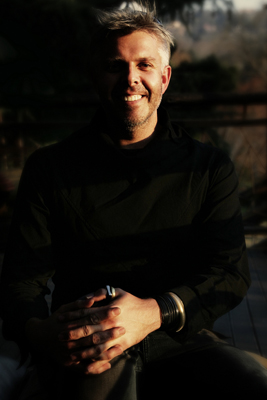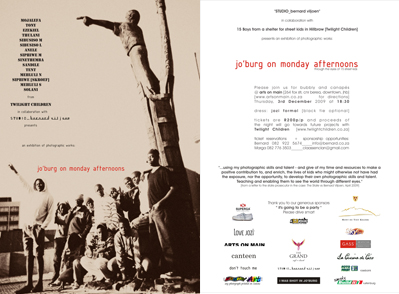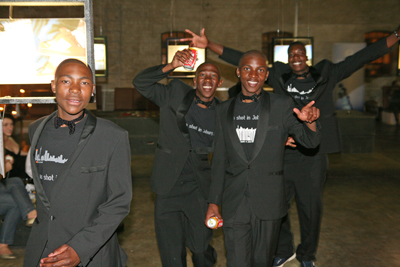N. Bernard Viljoen is a South African architect based in Johannesburg. He was raised on a farm in the Free State outside the quaint South African town, Parys. He graduated as an architect from the University of the Free State, Bloemfontein in 2001, and won the Corobrik National Student of the Year award that same year for his final year thesis project entitled: “…’N[9.]museum?…” This project consisted of a museum in the Karoo and questioned the “traditional” museum/exhibition space and the interaction of the spectator and the works on display therein. Furthermore, his project celebrated and acknowledged the Karoo (semi desert), with its subtle layering and vast emptiness. Since then, Bernard has accomplished a lot in his field and he continues to be recognized for his achievements and ethos.
Today though, I’m talking to Bernard about his involvement with the Twilight Children shelter for street kids in Hillbrow, Johannesburg. It was only a few months ago when I met with him in Rosebank for Savannas, where he showed me the website and project he was working on entitled, I was shot in Jo’burg. This was the evolution of his initial community service program, jo’burg on monday afternoons, which consisted of a photography course where 15 children had the opportunity to participate and document their surroundings, as well as exhibit the fruits of their labor at the Arts on Main in downtown Johannesburg in late 2009. The second stage of his community-based endeavor was I was shot in Joburg — a project that implemented the newly developed skills of the children by offering them a platform to generate income. I was shot in Joburg shoots portraits of people in public spaces or special events, which can then be purchased online and be printed on a T-shirt.
I had been looking for a community-based project that was sustainable – with potential for growth and inspiring those involved. Bernard is invested in the life, culture, and politics of South Africa and I was shot in Joburg is the ultimate manifestation of that very investment. His drive, passion, and professionalism have significantly elevated the conscious and lives of 15 street kids.
It is an absolute honor to present to you today N. Bernard Viljoen and Mojalefa, Tony, Ezekiel, Thulani, Sibusiso M., Sibusiso I., Anele, Siphiwe M., Sinethemba, Sandile, Tent, Mehluli N., Siphiwe [Skroef], Mehluli S., and Solani — who are part of the I was shot in Joburg team in Johannesburg, South Africa.
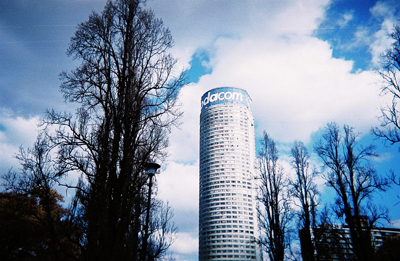
Sibusiso Mlaudzi (16 y.o.), "ponte+clouds+trees": “My favorite subject at school is mathematics because I want to become a pilot and I need to start working for it now.”
Georgia Kotretsos: Bernard, what has taken you from sustainable architecture to sustainable community work?
N. Bernard Viljoen: It all started on a horse carriage in Central Park, NY, with my friend, the fabulous Suzette Main. We drove past this beautiful building and Sue commented that that is what Camps Bay should look like. It turned out she had bought a building on the strip in Camps Bay and asked me to do a proposal for the design thereof. One thing led to another and in a few months, I found myself in Camps Bay working on this project with her. The Grand Café on Camps Bay soon opened its doors and many happy evenings were spent on the balcony sipping sparkling wine overlooking the Atlantic Ocean. One of those particular nights, on my way home I found myself in the midst of a roadblock. I won’t go into detail, but I spent a night in jail and appeared in front of the local magistrate soonafter. It was a bit of a “gedoente.” With the help of a good attorney and a magistrate with a vision, I was summonsed to community service. My attorney and I somehow managed to convince the magistrate that instead of washing buses or cleaning public toilets, I should rather do community service that would make a positive contribution to people’s lives. I suggested that I wanted to do a photography program with street kids — a project I always wanted to do but maybe just needed a little motivation for…
The program was proposed to and accepted by Twilight Children and their social worker assigned a group of 15 boys to me. We met every Monday afternoon from 2-5pm on the shelter’s premises. Each lesson was divided into an hour of theory followed by 2 hours of practical/field work.
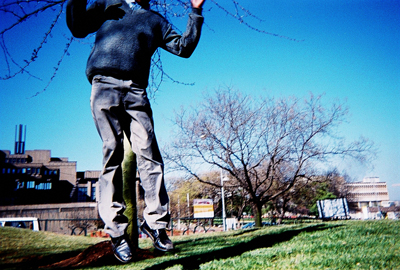
Solani Dube (19 y.o.), "I was shot in Jo'burg": “I would like to go to university and become a geologist. I love stones. My favorite stone is a diamond.”
I have succeeded in this if every kid is able to tell a story with their photos – their own — if I can make them feel worthy of sharing it with the world, visually documenting their stories, their observations, their hopes and dreams.
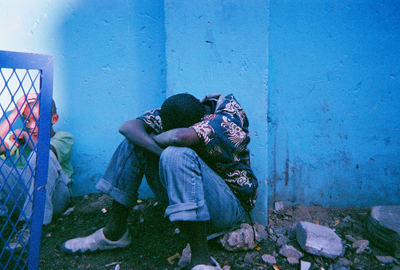
Anele Jali (16 y.o.), "untitled": “I like to take pictures of interesting things. When people see my photos, they see a story.”
Jo’burg on Mondays: […] They will learn how to search for beauty, for composition, for texture, for interesting subject matter where they thought there were none. They will learn that what they choose to see can impact those around them. They will learn that they can impact those around them.
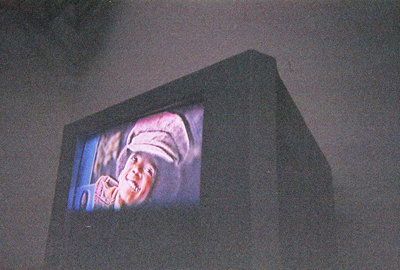
Siphiwe Magopheni (18 y.o.), "Michael Jackson is dead": “I love photography, because you see new and beautiful places. When you see something nice, it affects you always.”
I was shot in Joburg is a business venture established to provide a platform for street kids who received photography training through the Studio_Bernard Viljoen Foundation to apply their newly developed skills and generate an income from it… We visit happenings, events, and shows, where the kids and I take portraits of people attending. These photos are posted on our website and people can then buy them online as an iron-on transfer to recycle an old t-shirt or purchase their photo on one of our garments. [The project] has taken on greater depth and has become more meaningful and sustainable in the long run for these kids. The main objectives and drive of the “STUDIO_bernard viljoen photography skills development fund for street kids” will be:

Sibusiso Lokwe (16 y.o.), "stop says the red light": “I play soccer to keep me busy. I also like drama and playing volleyball. I’m at my happiest when I’m with my friends.”
- Using our photographic skills and talent and give our time and resources to make a positive contribution to, and enrich the lives of kids who might otherwise not have had the exposure nor the opportunity to develop their own photographic skills and talent.
- Creating a self-sustaining business environment, wherein these kids can apply their newly developed skills in order to generate an income, while at the same time contributing to the fund to help other kids in the same kind of situation.

Left: Tony Sithole (14 y.o.) – "All alone!!!": “I write poems because it explains how I feel about something. I have seen things in the streets before I came here and with poetry I can explain them in my own way.” Right: Tony Sithole's photograph installed at Art on Main, 2009
GK: What did it take to pull the show at Arts on Main in 2009 off? How was the show perceived by both the artists and the audience of Johannesburg? What did it mean to you?
NBV: As with the rest of the project, the exhibition took on a life of its own far greater than ever anticipated…
The initial idea was to have the exhibition in my apartment with friend and colleagues. As the project progressed and the negatives came back from my local one-hour lab every other week, both the kids and I became very excited about the images of downtown Jo’burg that were captured. The images initially were naive yet very real. The children started to understand light, composition, color, contrast, texture, and interesting subject matter. You see, something we forgot in this techno-advanced life we are living is that a disposable camera allows the photographer no setting in terms of light, zoom, depth of field…you literally just point and shoot and hope for the best. So we all soon realized that there are a few basic principles to apply in order to ensure exposure on our expired sponsored disposable cameras:
a. Make sure you shoot at something big or close or interesting enough
b. Or if you can’t find any of the above – make sure it is red
c. Make sure there is enough light [shadowed objects – not a good idea]
d. Make sure you center your object – the camera’s viewfinders are not as calibrated as one would think
e. Make sure you ask permission to shoot people or their things
e. And if you can predict that they are either going to say no or ask for money, you have to master the technique of shooting while walking and looking in the opposite direction.
f. Never put your camera away – even if your roll of film is full. This small blue point-and-shoot device gave us freedom to walk in the very dangerous streets of Hillbrow in downtown Johannesburg. It elevated us above the daily street life and was a passport to look, to point, to stare, to stop and to capture…
To get back to the exhibition, on one of our Monday afternoon excursions through the streets of Hillbrow, I took the kids to the local art gallery, JAG – Johannesburg Art Gallery. [Ideas] that came under discussion were name, theme, title, artist, photographer, spectator, and spectated. And always interesting subject matter. [The boys] loved the idea of being seen as photographers — artists if you like. Pride filled their chests at the idea of having a voice. Not something they are used to. Excitement got the better of them at the realization that their names would accompany a photograph [in] the exhibition. They started looking at the streets, people, happenings, and daily life slightly different. They were searching for interesting subject matter, for stories worth telling. For red if all else fails. A stop sign became the anchor for a composition; broken windows the rhythm for their voices; a sitting child a conversation starter. They were protecting their cameras like a bulldog would do so with a bone. They were protecting their hope.
I realized my flat is too small for this collaboration and emerging artists. I contacted Benjamin Liebman at Arts on Main, a hub for Johannesburg’s art community, situated in downtown Johannesburg. With a unique blend of studio, commercial, residential and retail spaces, Arts on Main is a creative community to develop and share ideas. Liebman made his main exhibition space available to us for our one-night exhibition called Jo’burg on Monday afternoons – through the eyes of 15 street kids. William Kentridge’s studio is at Arts on Main too – something interesting worth mentioning.
For six months [on] every Monday afternoon, a taller than average white male walked the predominantly black, dangerous streets of Hillbrow with 15 boys carrying disposable cameras. If you were to ask me if I blended in, I would say no. If you were to ask me if I was scared, I would say I walked like I owned Hillbrow. If you were to ask me if I was out of my comfort zone, I would say definitely. If you were to ask me if I would ever forget those adrenaline bursts of eyes watching us, following us, I would say no.

N. Bernard Viljoen and the Twilight Children at the exhibition night of "jo'burg on monday afternoons," Arts on Main, 2009
If you were to ask me if I could have chosen to be anywhere on those Monday afternoons, I would have chosen to be right there. If you were to ask me how to prepare the kids for the exhibition, I would say I don’t know. I did, however, explain to them how I felt walking the streets with them — how I had to figure out a way to belong, to take, to give, and to be part of the streets. They kind of understood.
The night arrived; the kids were involved in choosing the best images to go on exhibition, invites, titles. They helped to set up the venue, to hang the beaded light boxes I commissioned the beading center at Twilight Children to make. Friends flew in from Cape Town to help; others drove all over Johannesburg to find the right double-sided tape. My mom brought help and moral support from the farm. Over 200 people arrived [and] the kids looked fabulous. All nerves shattered as I introduced them to the guests who burst into applause after each photographer I introduced…They thought they were rock stars; they still do, if you ask me… Sandile, the oldest kid, made a speech…The kids mingled and chatted and explained their work like they had been doing this for their whole lives… It was a great success…I wanted to create an evening these children would never forget for as long as they live…perceptions were challenged that night….words that flew around were composition, beauty, street kid, hope, red, disposable camera, shelter, bubbly, canapés, Johannesburg, dangerous, sublime, police, happy, thank you, good night.
And, that’s a wrap!

